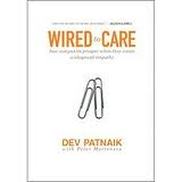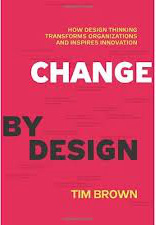 At the dschool, I heard about the book Wired to Care by Dev Patnaik, CEO of Jump Associates and professor at Stanford. The book focused on the subject of empathy, which is the first (and perhaps most difficult and critical) of the five steps of the design thinking process. I found the book enjoyable and easy to read, and I liked its many examples and stories of individuals at companies finding empathy with others. I found myself wanting more specific advice from the book on techniques for more effective empathy interviewing and observation, as well as how to turn those observations into ideas, how to best document them, and how to best communicate them with others. The book stayed too high level for me, even though it was interesting and well written. My biggest takeaway is that empathy and a deep connection with customers can make even "uninteresting" products strike a chord, and it can motivate people to work their hardest because they have a deeper goal in mind. I also think the lesson of "the map is not the territory" is very powerful and a great reminder of the importance of seeing things first-hand and doing your own thinking rather than just relying on second-hand information. Part 1 the case for empathy Ch 1 intro
Ch 4 creating affinity
Ch 8 reframe
1 Comment
 Last week, I attended a really cool event at the intersection of design and augmented reality (AR): the VOX Summit. We had some great speakers (including one of my favorite authors, Daniel Suarez), and we broke up into smaller groups to prototype how AR can be used effectively in fields like robotics, education, and storytelling. I learned a lot about the state of the art in the field and got to play with some AR apps (and learned how to drop my own AR objects into the "world"). I really enjoyed Daniel Suarez's and Blaise Aguera y Arcas's talks, and their messages about the pros and cons of the world we're in the process of creating resonated with me. Below are some of my notes and takeaways. a. design thinking ii. AR as new medium 2. “We should build good ships here; at a profit if we can, at a loss if we must, but always good ships.” 3. always good experiences i. augmentedreality.org IV. Daniel Suarez a. Shamanism/Daemon b. Present-adjacent (not too far) c. He’s optimistic about future d. Remote-controlled drones almost obsolete because can jam communication e. Pushes decision-making to drone itself f. False consensus in social media; scripts creating fake trends g. Perception is reality h. Network needs to be more reliable for DarkNet i. Things need to default to being encrypted to freely exchange ideas j. People voting several times a day for local issues k. Afraid of weapons systems that have credit card and can direct itself (Razorback) l. New social system as a lifeboat in case old system dies m. Hole-in: self-contained system but which is informed by other parts and can evolve n. IP becomes something more fluid; the plan is original idea you own and others can build on top and you get some percent over time as it evolves o. AR beginning of something very big b. AR and entertainment c. Augmented Hollywood d. Hollywood as how ppl should tell stories e. AR needs to fulfill a fantasy/wish f. Tie in to wish fulfillment of the film h. Remove barriers i. Augmented movies i. Terminator ii. Minority report iii. Iron man j. Augmented theater i. Conspiracy for Good ii. Storylines iii. Augmented reality cinema app k. The Witness: the first movie in the outernet l. Augmented marketing m. Citadel movie i. View clips via posters n. Iron Man face AR experience/game i. Wish fulfillment of becoming hero ii. Social element of sharing your pic w/ friends o. Augmented books i. Ice Age book trigger cards ii. Wonderbook book of spells 1. Magic mirror effect on TV iii. Art of Journey book to visualize art in 3D a. Blaise Aguera y Arcas ii. Online services, Microsoft iii. Training in physics and applied math 1. Never studied CS or design iv. Seadragon 1. Founded company 2. Multiresolution images v. Photosynth 2. Acquired by MSFT in 2007 3. Started as grad student project at UW vi. Bing mobile vii. Next viii. Interaction design 1. Art deco 2. Helvetica ix. Design of systems based on math x. Portfolio 1. Gasbar a. Progress bar b. Not 1 degree of freedom (% done) but 3 (% done, uncertainty, how much activity going on now) c. Using particles representing activity d. Modeling fluid gas transition 2. Streetside a. Navigation in street view b. Rotation is easy (photos on cube/skybox) c. But translation is hard because model environment d. Sense of parallax weak; just need actual good imagery, not complex space e. Simplified the geometry the image is projected on f. Potemkin village geometry i. Handful of polygons for entire scene 3. On{x} a. Israeli project b. Ifttt for mobile c. Recipes d. JS APIs e. People hated that it required facebook login f. Very closely connected to Node.JS i. 1 language for front and back ii. everything is reactive iii. callbacks on events iv. nothing ever blocks, all async g. android i. ease of creating app and using internal signals makes it easy for anyone to violate privacy in app ii. phone is not a phone; it’s a computer 4. Incoming call a. Daemon.js b. Looking up unknown numbers on web on incming calls 5. Thinking about design mathematically 6. Interactions define behavior of app and shape of our relationship w/ real world 7. Lineage of phones inheriting from PCs not phones a. Still desktop w/ icons b. How far can AR go if stands in silos of apps that require its own app to be downloaded i. Pull vs. push ii. How to push AR info to ppl w/o app c. Single AR key broker vs. open vs. secure i. Need cheaper signals to do more expensive operations like vision recognition d. CV is advancing fast, but app model is broken e. Wii -> Kinect transition to naturalness f. Problem of the vanishing physical i. Kindle books getting removed from your shelf on copyright violations ii. Book metaphor vs. online service metaphor iii. What of what we produce is real vs not iv. 15th century books still look great v. is our current product ephemeral? vi. Embodied objects vs. not VII. Helen Papagiannis talk @arstories a. Augmented reality as a new medium for storytelling b. Always build a good ship c. Moonshot d. Reveal e. Delight f. Engage g. Make h. Reimagine i. Use tools to change the rules j. New planet k. Dreamer l. Emotional journey m. Iterative n. Retention o. Engrossing p. Curiosity q. Wonderment s. Make mistakes faster t. @MarsCuriosity: Roads? Where I’m going, I don’t need roads. u. The Future Belongs to the Curious video v. Ask questions  I've been getting deep into design thinking and heard the book Change by Design by Tim Brown mentioned repeatedly, so I figured I'd check it out. Tim Brown is the CEO of the design firm IDEO, which, along with the Stanford d.school, really spearheaded a lot of the design thinking movement. I found the book to be a great overview of DT and recommend it to anyone unfamiliar with the subject. I personally would've wished for the book to spend more time on specific techniques and less on the broader trends and high-level concepts since most of those are already familiar. I suppose there wasn't a lot of depth on the techniques because this stuff is much better learned by doing rather than reading. I did find the copious number of real-world examples where DT made a difference to be interesting. Below are my main takeaways from the book that go beyond what I learned before or present the material from a different perspective. Intro
Part 1 what is design thinking Ch 1 dt is about more than style
3 spaces of innovation
The brief
Creative culture and environment
Ch 2 converting needs into demand or putting ppl first
Insight
Observation
Empathy
Consumers as part of design team
Ch 3 a mental matrix or these ppl have no process
Convergent and divergent thinking
Brainstorming
Visual thinking
Ch 4 building to think or the power of prototyping
Quick and dirty
Acting out
Prototyping in the wild DT for company reorg
Ch 5 returning to the surface or the design of experiences
Experience blueprint
Ch 6 spreading the message or the power of storytelling
Designing in fourth dimension
Stories as product
Design challenge
Part 2 where do we go from here Ch 7 design thinking meets the corporation or teaching to fish
Ch 8 new social contract or we're all In this together
Blurring between products and services
Sustainability Ch 9 design activism or inspiring solutions with great potential
Ch 10 designing tomorrow today
|
Archives
June 2024
Categories
All
Subscribe |
 RSS Feed
RSS Feed
